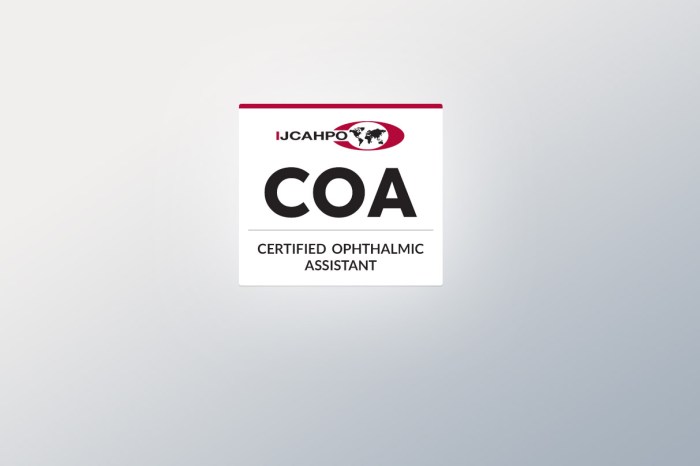The ophthalmic assistant certification practice test stands as an indispensable tool for individuals seeking to excel in the field of ophthalmic assisting. Embark on a journey of knowledge and skill development as we delve into the intricacies of this comprehensive resource, designed to empower you with the confidence and competence necessary to conquer the certification exam.
Delve into the structure and format of the practice test, unraveling the sections, question types, time limits, and scoring systems that await you. Familiarize yourself with the content covered, ranging from core ophthalmic concepts to practical skills, ensuring that no stone is left unturned in your preparation.
1. Introduction to Ophthalmic Assistant Certification Practice Test

An ophthalmic assistant certification practice test is a valuable tool for individuals preparing for the Ophthalmic Assistant Certification Exam. It helps candidates assess their knowledge and skills, identify areas for improvement, and gain confidence before taking the actual exam.
Importance of Preparing for the Certification Exam
Preparing for the certification exam is crucial because it:
- Demonstrates professional competence and commitment to the field
- Enhances job prospects and career advancement opportunities
- Provides a benchmark for measuring knowledge and skills
Benefits of Taking a Practice Test
Taking a practice test offers numerous benefits, including:
- Identifies knowledge gaps and areas requiring further study
- Familiarizes candidates with the test format and question types
- Helps develop time management skills and improves test-taking strategies
- Reduces test anxiety and boosts confidence
2. Structure and Format of the Practice Test

The ophthalmic assistant certification practice test typically consists of multiple sections covering various aspects of ophthalmic assisting.
Sections and Question Types
Common sections include:
- Patient Care and Safety
- Ophthalmic Examination and Diagnosis
- Ophthalmic Procedures and Therapeutics
- Pharmacology
- Ophthalmic Equipment and Instrumentation
Question types may include multiple choice, true/false, fill-in-the-blank, and case-based scenarios.
Time Limit and Scoring System
The practice test typically has a time limit similar to the actual exam, allowing candidates to practice pacing themselves. Scoring systems vary, but most tests provide immediate feedback on performance.
Practice Questions
Here are examples of practice questions to familiarize candidates with the format:
- Which of the following is a common cause of conjunctivitis?
- True or False: The Snellen chart is used to measure visual acuity.
- Fill in the blank: The instrument used to measure intraocular pressure is called a ____.
- Describe the steps involved in performing a dilated fundus examination.
3. Content Covered by the Practice Test
The practice test covers a comprehensive range of topics and skills essential for ophthalmic assistants.
Major Topics
Major topics include:
- Anatomy and physiology of the eye
- Ophthalmic history taking and physical examination
- Diagnostic testing and procedures
- Ophthalmic medications and pharmacology
- Patient education and counseling
Key Concepts and Skills
Candidates should focus on key concepts and skills such as:
- Understanding the role and responsibilities of an ophthalmic assistant
- Maintaining patient safety and confidentiality
- Performing ophthalmic examinations and procedures accurately and efficiently
- Administering ophthalmic medications and therapies
- Communicating effectively with patients and healthcare professionals
Content Areas Covered, Ophthalmic assistant certification practice test
The practice test covers specific content areas, including:
- Ophthalmic anatomy and physiology
- Ophthalmic examination techniques
- Ophthalmic diagnostic testing
- Ophthalmic surgical procedures
- Ophthalmic pharmacology
- Patient care and counseling
- Ethics and legal issues in ophthalmic assisting
4. Study Tips and Strategies
Effective study methods can enhance performance on the practice test and the actual certification exam.
Study Methods
Recommended study methods include:
- Reviewing ophthalmic textbooks and study guides
- Attending continuing education courses and workshops
- Joining study groups or online forums
- Practicing question-answering techniques
Time Management and Question-Answering Techniques
Time management is crucial during the practice test. Candidates should:
- Allocate time wisely for each question
- Skip difficult questions and return to them later
- Use process of elimination to narrow down answer choices
- Read questions carefully and identify s
Reviewing Results
After completing the practice test, it is essential to review the results and identify areas for improvement.
- Analyze incorrect answers to understand misconceptions
- Focus on strengthening weak areas through additional study
- Consider seeking guidance from a mentor or tutor if needed
5. Benefits of Using a Practice Test

Taking a practice test provides numerous advantages for ophthalmic assistant certification candidates.
Identifying Knowledge Gaps
Practice tests help candidates identify knowledge gaps and areas where further study is required. By highlighting weaknesses, candidates can target specific topics for improvement.
Improving Test-Taking Skills
Practice tests familiarize candidates with the test format, question types, and time constraints. This improves test-taking skills, reducing anxiety and increasing confidence on the actual exam.
Boosting Confidence
Performing well on a practice test can boost confidence and reduce test anxiety. Candidates who feel prepared and confident are more likely to succeed on the actual exam.
Reducing Test Anxiety
By becoming familiar with the test format and question types, practice tests help reduce test anxiety. Candidates who know what to expect are less likely to feel overwhelmed or stressed during the actual exam.
6. Additional Resources for Preparation
In addition to the practice test, candidates can access various resources to support their preparation.
Study Materials and Resources
Recommended study materials and resources include:
- Ophthalmic textbooks and study guides
- Online courses and webinars
- Continuing education workshops and seminars
- Study groups and online forums
Relevant Websites and Organizations
The following websites and organizations provide valuable information and resources for ophthalmic assistant certification candidates:
- American Academy of Ophthalmology (AAO)
- Joint Commission on Allied Health Personnel in Ophthalmology (JCAHPO)
- Ophthalmic Assistants Society of America (OASA)
- National Board for Certification in Ocularistry (NBCO)
Frequently Asked Questions
What is the purpose of an ophthalmic assistant certification practice test?
The ophthalmic assistant certification practice test is designed to provide individuals with an accurate representation of the actual certification exam, allowing them to assess their knowledge and skills, identify areas for improvement, and build confidence in their preparation.
What are the benefits of taking a practice test?
Taking a practice test offers numerous benefits, including identifying knowledge gaps, improving test-taking skills, boosting confidence, and reducing test anxiety. It allows individuals to become familiar with the exam format, time constraints, and question types, enhancing their overall preparedness.
What content is covered by the practice test?
The practice test covers a comprehensive range of topics and skills relevant to the ophthalmic assistant certification exam, including anatomy and physiology of the eye, ophthalmic examination techniques, patient care and management, and pharmacology. It ensures that individuals are well-prepared in all aspects of ophthalmic assisting.